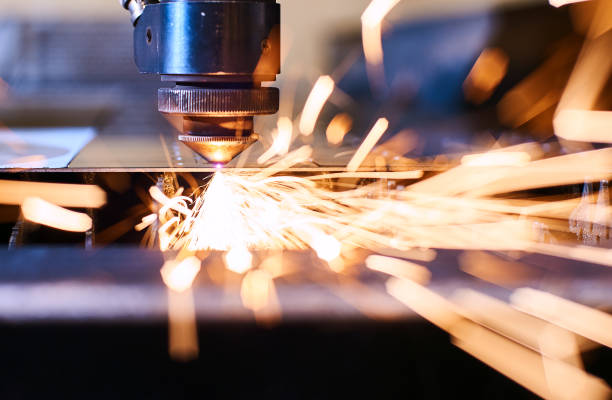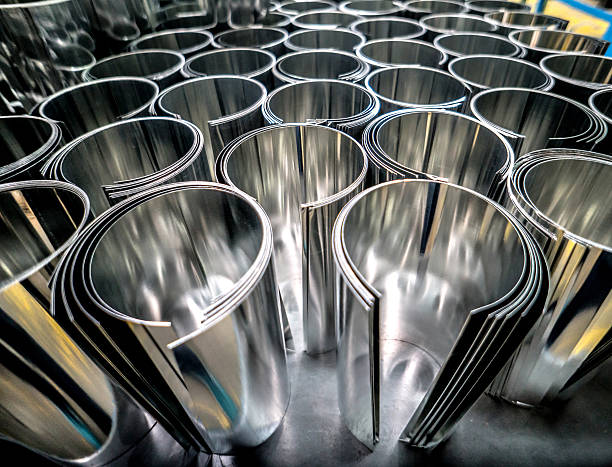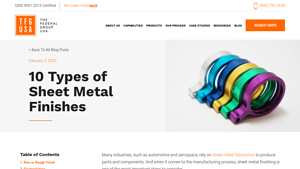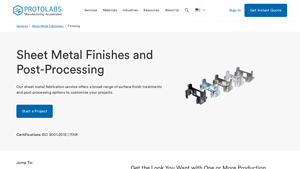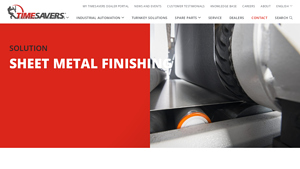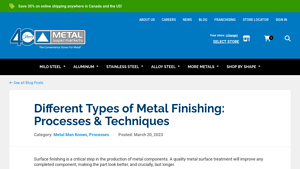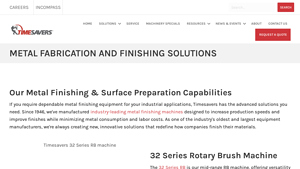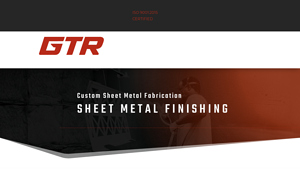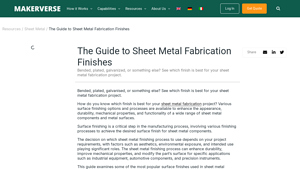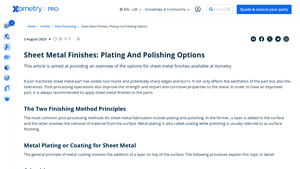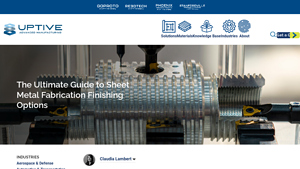Sheet Metal Finishing Guide: Type, Cost, Top List…
Introduction: Navigating the Global Market for sheet metal finishing
Navigating the complexities of sourcing sheet metal finishing solutions can be daunting for international B2B buyers, especially those operating in diverse markets such as Africa, South America, the Middle East, and Europe. With a myriad of finishing options available—ranging from anodizing and electroplating to powder coating and bead blasting—each presenting distinct benefits and applications, making the right choice is crucial for ensuring product quality and performance. This guide serves as a comprehensive resource, meticulously detailing the various types of finishes, their specific applications across industries, and actionable insights on supplier vetting processes.
In addition to exploring the intricacies of different finishing techniques, the guide addresses critical factors that influence costs and availability, helping you navigate the global marketplace effectively. By equipping B2B buyers with the knowledge needed to make informed decisions, this resource empowers you to enhance your procurement strategies and optimize your supply chain. Whether you are based in Vietnam or Germany, understanding the nuances of sheet metal finishing will position your business to meet stringent industry standards while maximizing operational efficiency. Dive into this guide to unlock the potential of sheet metal finishing and elevate your manufacturing capabilities.
Understanding sheet metal finishing Types and Variations
| Type Name | Key Distinguishing Features | Primary B2B Applications | Brief Pros & Cons for Buyers |
|---|---|---|---|
| Raw or Rough Finish | Unfinished surface; retains natural texture | Pharmaceutical, automotive, chemical industries | Pros: Cost-effective; Cons: Limited aesthetic appeal |
| Electroplating | Metal layer applied through electrodeposition | Jewelry, automotive components | Pros: Enhances appearance; Cons: Can be less durable than other finishes |
| Anodizing | Electrochemical process creating a durable oxide layer | Automotive, architectural elements | Pros: Corrosion-resistant; Cons: Limited to aluminum |
| Powder Coating | Dry powder application followed by baking | Industrial equipment, consumer goods | Pros: Variety of colors; Cons: Requires curing time |
| Electropolishing | Electrical process that smoothens and shines surfaces | Medical devices, food processing equipment | Pros: Improved cleanliness; Cons: Higher cost due to complexity |
What are the Characteristics of Raw or Rough Finish in Sheet Metal?
A raw or rough finish is characterized by its unrefined appearance, retaining the natural texture of the base material. This finishing type is often used in environments where aesthetics are not critical, such as in pharmaceutical or chemical plants, where stainless steel’s natural corrosion resistance suffices. For B2B buyers, choosing this finish can lead to significant cost savings, but it may not meet the visual standards required for consumer-facing products.
How Does Electroplating Enhance Sheet Metal Products?
Electroplating involves depositing a layer of metal onto the surface of the sheet metal through an electrical process. This technique is widely used in industries such as jewelry and automotive, where a visually appealing finish is essential. While electroplating can enhance the aesthetic and protective qualities of metal parts, buyers should consider that it may not be as durable as other finishes, potentially leading to increased maintenance costs over time.
Why is Anodizing a Preferred Choice for Aluminum Sheet Metal?
Anodizing is an electrochemical process that converts the surface of aluminum into a durable oxide layer, enhancing its corrosion resistance. This finish is particularly popular in the automotive and architectural industries, where durability and visual appeal are crucial. B2B buyers should note that while anodizing provides excellent protection, it is limited to aluminum substrates, which may restrict its applicability in diverse manufacturing environments.
What Advantages Does Powder Coating Offer for Metal Finishes?
Powder coating is a finishing process that applies a dry powder to the metal surface, followed by a baking process that cures the coating. This method is favored in various sectors, including industrial equipment and consumer goods, due to its wide range of color options and durability. Buyers should weigh the benefits of aesthetic variety against potential longer lead times due to curing processes, which can affect project timelines.
How Does Electropolishing Improve the Quality of Sheet Metal?
Electropolishing is a sophisticated finishing technique that uses an electrical current to remove surface imperfections and create a smooth, shiny finish. This process is particularly beneficial in industries such as medical devices and food processing, where cleanliness and corrosion resistance are paramount. While it enhances product quality, B2B buyers should be prepared for higher costs associated with this complex procedure, which may not be justified for all applications.
Key Industrial Applications of sheet metal finishing
| Industry/Sector | Specific Application of Sheet Metal Finishing | Value/Benefit for the Business | Key Sourcing Considerations for this Application |
|---|---|---|---|
| Automotive | Anodizing for automotive components | Enhances corrosion resistance and aesthetic appeal | Ensure compliance with automotive standards and regulations |
| Aerospace | Electropolishing for aircraft parts | Reduces weight, improves durability, and enhances performance | Look for suppliers with aerospace certifications and experience |
| Construction | Powder coating for structural elements | Provides a durable, weather-resistant finish | Consider local suppliers for reduced shipping costs and environmental impact |
| Electronics | Electroplating for circuit boards | Improves conductivity and protects against corrosion | Verify the quality and reliability of the finishing process |
| Food and Beverage | Buff polishing for processing equipment | Ensures hygiene and easy cleaning | Source from suppliers with food safety certifications |
How is Sheet Metal Finishing Used in the Automotive Industry?
In the automotive sector, anodizing is a prevalent finishing process applied to components such as wheels, brackets, and engine parts. This technique enhances corrosion resistance while providing an aesthetically pleasing surface that can be colored. For international buyers, especially from regions like Africa and South America, it’s vital to ensure that the anodized parts meet local automotive standards and regulations. Additionally, sourcing from suppliers with a proven track record in the automotive industry can mitigate risks related to quality and performance.
What Role Does Sheet Metal Finishing Play in Aerospace Applications?
Electropolishing is crucial in the aerospace industry, particularly for components that require a high degree of precision and performance, such as turbine blades and fuel systems. This finishing process removes surface imperfections, resulting in smoother surfaces that reduce drag and improve fuel efficiency. Buyers from Europe and the Middle East should prioritize suppliers who possess aerospace certifications and demonstrate adherence to stringent quality control measures, ensuring that the finished parts can withstand the demanding conditions of flight.
How is Sheet Metal Finishing Applied in Construction Projects?
In construction, powder coating is widely used to finish structural elements like railings, doors, and frames. This finishing method provides a durable and weather-resistant layer that enhances the lifespan of metal components exposed to various environmental conditions. For B2B buyers in regions like Africa, sourcing locally can be advantageous to minimize shipping costs and support sustainability efforts. Additionally, understanding the specific color and texture requirements for architectural projects can ensure that the finished products align with design standards.
Why is Sheet Metal Finishing Important for Electronics?
Electroplating is a vital finishing technique in the electronics sector, particularly for circuit boards and connectors. This process not only improves electrical conductivity but also offers a protective layer against corrosion, which is essential for maintaining the longevity and reliability of electronic devices. Buyers, especially from emerging markets, should evaluate suppliers based on their expertise in electroplating processes and their ability to meet international quality standards, ensuring that the components perform effectively in various applications.
How Does Sheet Metal Finishing Contribute to the Food and Beverage Industry?
Buff polishing is critical in the food and beverage sector, where hygiene and cleanliness are paramount. This finishing method creates a smooth, reflective surface on processing equipment, making it easier to clean and maintain sanitary conditions. International buyers must ensure that their suppliers comply with food safety regulations and certifications, as this can significantly impact the safety and quality of the food products being processed. Additionally, sourcing from manufacturers who specialize in food-grade finishes can provide peace of mind regarding product integrity.
3 Common User Pain Points for ‘sheet metal finishing’ & Their Solutions
Scenario 1: Inconsistent Finish Quality Across Products
The Problem: B2B buyers often face issues with inconsistent finish quality across batches of sheet metal products. This inconsistency can stem from various factors, including variations in the finishing process, equipment malfunctions, or differing operator skill levels. When parts are intended for high-visibility applications, such as automotive interiors or consumer products, uneven finishes can lead to brand damage and increased rejection rates during quality control inspections. Buyers are left frustrated, knowing that a lack of uniformity could result in additional costs for rework or replacement.
The Solution: To combat inconsistent finish quality, buyers should prioritize establishing clear specifications and standards with their finishing suppliers. Start by conducting a thorough assessment of the finishing processes used by potential suppliers. Request samples from different batches to evaluate the finish quality, and consider implementing a quality assurance program that includes regular audits of the supplier’s processes. Additionally, establishing a feedback loop where your team can communicate issues directly with the supplier can lead to quicker resolutions. By fostering a collaborative relationship and ensuring both parties understand the desired outcome, you can significantly enhance the consistency of your sheet metal finishes.
Scenario 2: Difficulties in Meeting Environmental Compliance Standards
The Problem: In today’s global market, environmental regulations are becoming increasingly stringent, particularly in regions such as Europe and North America. Buyers in industries such as automotive and aerospace often struggle to find finishing processes that comply with these regulations while still meeting their performance and aesthetic requirements. Traditional finishing methods, such as certain types of plating or painting, may involve hazardous materials or produce significant waste, leading to compliance headaches and potential penalties.
The Solution: Buyers should proactively seek out suppliers that specialize in environmentally friendly finishing options. Consider alternatives like powder coating or electroless plating, which often have lower environmental impacts and can comply with regulations. Additionally, inquire about the supplier’s waste management and recycling practices, as well as their certifications related to environmental compliance. Working closely with suppliers that have a strong commitment to sustainability can not only help you meet regulatory requirements but also enhance your company’s reputation as an environmentally responsible partner.
Scenario 3: Challenges in Post-Finishing Processing
The Problem: After sheet metal finishing, buyers often encounter challenges with post-processing, such as painting or assembly. Finishes like anodizing or powder coating can create surfaces that are difficult for adhesives or paints to bond to, leading to poor adhesion and product failure. This issue is particularly critical in industries where durability and performance are paramount, such as aerospace and defense. The need for additional surface preparation before further processing can result in increased lead times and costs.
The Solution: To address post-finishing processing challenges, it’s essential to choose the right finishing technique from the outset. Consult with finishing suppliers about the specific requirements for subsequent processing. For instance, if you plan to paint over anodized aluminum, ensure that the finishing process includes a suitable surface treatment to enhance paint adhesion. Techniques like bead blasting can create the necessary surface profile for better bonding. Additionally, consider collaborating with your finishing supplier to develop an integrated approach that aligns with your entire production process, ensuring that each step is optimized for the next. By aligning finishing choices with post-processing needs, you can streamline operations and reduce the risk of product failure.
Strategic Material Selection Guide for sheet metal finishing
What Are the Key Properties of Common Sheet Metal Finishing Materials?
When selecting materials for sheet metal finishing, it is essential to consider their specific properties that impact product performance. Here, we analyze four common materials: stainless steel, aluminum, carbon steel, and copper, highlighting their key properties, advantages, disadvantages, and implications for international B2B buyers.
Stainless Steel: A Versatile Option for Many Applications
Key Properties: Stainless steel is renowned for its corrosion resistance, high-temperature tolerance, and strength. It typically withstands temperatures up to 800°C (1472°F) and is suitable for various environments, including those exposed to moisture or chemicals.
Pros & Cons: The durability of stainless steel makes it ideal for applications in the automotive and aerospace industries. However, its higher cost compared to other metals can be a limitation for budget-conscious projects. Additionally, the manufacturing complexity may increase due to the need for specialized tools and processes.
Impact on Application: Stainless steel is compatible with a wide range of media, including water, oils, and chemicals, making it suitable for food processing and medical equipment.
Considerations for International Buyers: Compliance with international standards such as ASTM A240 or DIN 1.4301 is crucial. Buyers from regions like Europe and the Middle East often prefer stainless steel for its aesthetic appeal and longevity.
Aluminum: Lightweight and Corrosion-Resistant
Key Properties: Aluminum is lightweight, with excellent corrosion resistance and thermal conductivity. It can withstand moderate temperatures, typically up to 600°C (1112°F), making it suitable for various applications.
Pros & Cons: The primary advantage of aluminum is its low weight, which is beneficial in industries like automotive and aerospace. However, it may not be as durable as stainless steel under high-stress conditions. Additionally, the cost can vary significantly based on the alloy used.
Impact on Application: Aluminum is compatible with various media but may not perform well in highly acidic or alkaline environments. Its anodized finish enhances corrosion resistance and aesthetic appeal.
Considerations for International Buyers: Buyers should be aware of common standards like ASTM B221 and JIS H 4000. In regions such as Africa and South America, where weight savings are critical, aluminum is often favored.
Carbon Steel: Strength and Cost-Effectiveness
Key Properties: Carbon steel offers high strength and durability, making it suitable for heavy-duty applications. However, it is prone to corrosion without proper finishing treatments, such as galvanization.
Pros & Cons: The cost-effectiveness of carbon steel makes it an attractive option for many industries. However, its susceptibility to rust requires additional protective coatings, which can complicate manufacturing processes.
Impact on Application: Carbon steel is compatible with various media but requires careful consideration in corrosive environments. It is commonly used in construction and automotive applications.
Considerations for International Buyers: Compliance with standards like ASTM A36 and DIN EN 10025 is essential. Buyers from Europe may prefer carbon steel for its structural applications, while those from Africa may prioritize cost over corrosion resistance.
Copper: Excellent Conductivity and Aesthetic Appeal
Key Properties: Copper is known for its excellent electrical and thermal conductivity, making it ideal for electrical applications. It also has inherent antimicrobial properties, which are advantageous in medical settings.
Pros & Cons: The aesthetic appeal of copper is a significant advantage for decorative applications. However, its higher cost and susceptibility to corrosion can limit its use in certain environments.
Impact on Application: Copper performs well in electrical and plumbing applications but may not be suitable for outdoor use without protective coatings.
Considerations for International Buyers: Buyers should consider standards like ASTM B370. In regions like the Middle East, where aesthetics and functionality are critical, copper is often chosen for architectural applications.
Summary Table of Material Selection
| Material | Typical Use Case for sheet metal finishing | Key Advantage | Key Disadvantage/Limitation | Relative Cost (Low/Med/High) |
|---|---|---|---|---|
| Stainless Steel | Automotive, Aerospace | Corrosion resistance and durability | Higher cost and manufacturing complexity | High |
| Aluminum | Automotive, Aerospace | Lightweight and corrosion-resistant | Less durable under high-stress conditions | Medium |
| Carbon Steel | Construction, Automotive | Cost-effective and strong | Prone to corrosion without finishing | Low |
| Copper | Electrical, Plumbing, Decorative | Excellent conductivity and aesthetics | Higher cost and corrosion susceptibility | Medium |
This strategic material selection guide provides B2B buyers with critical insights into the properties, advantages, and limitations of common materials used in sheet metal finishing. Understanding these factors will help in making informed decisions that align with project requirements and regional preferences.
In-depth Look: Manufacturing Processes and Quality Assurance for sheet metal finishing
What Are the Main Stages in the Manufacturing Process of Sheet Metal Finishing?
The manufacturing process for sheet metal finishing involves several critical stages, ensuring that the final product meets industry standards and client specifications. Each stage plays a unique role in transforming raw materials into finished components suitable for various applications, from automotive to aerospace.
How Is Material Prepared for Sheet Metal Finishing?
Material preparation is the foundational step in sheet metal finishing. It begins with selecting the right type of metal, such as aluminum, stainless steel, or carbon steel, based on the project’s requirements. This stage involves cutting the metal sheets to the desired dimensions using techniques like laser cutting or waterjet cutting.
Once the sheets are cut, they undergo surface cleaning to remove any contaminants, oils, or oxidation that may affect subsequent finishing processes. Common cleaning methods include chemical cleaning or abrasive blasting. Proper material preparation ensures better adhesion of finishes and improves the overall aesthetic and functional quality of the final product.
What Techniques Are Used in Forming Sheet Metal?
The forming stage involves shaping the prepared sheets into the required geometries. Techniques such as bending, stamping, and deep drawing are commonly employed. Bending can be performed using press brakes, while stamping often utilizes dies to create complex shapes. Deep drawing is used for creating hollow shapes and is particularly relevant in industries requiring precision parts.
During this stage, it is crucial to monitor the metal’s stress and strain to avoid defects such as cracking or deformation. Advanced technologies such as CNC (Computer Numerical Control) machines enhance accuracy and repeatability in forming processes, which is vital for maintaining quality across multiple production runs.
How Is Assembly Conducted in the Manufacturing Process?
Once the individual components are formed, the assembly stage brings them together to create the final product. This can involve welding, fastening, or adhesive bonding, depending on the application and material compatibility.
For instance, welding is prevalent in structural applications where strength is paramount, while fastening might be more suitable for components requiring disassembly or maintenance. The assembly process must also consider tolerances and alignment, which are critical for ensuring the functionality of the final product.
What Finishing Techniques Are Commonly Used in Sheet Metal Production?
Finishing techniques are essential for enhancing the appearance and performance of sheet metal products. Some of the most common methods include:
- Electroplating: A process that applies a metallic coating to improve corrosion resistance and aesthetics.
- Anodizing: Primarily used for aluminum, anodizing enhances corrosion resistance and allows for coloration.
- Powder Coating: This technique provides a durable and visually appealing finish by applying a dry powder that is then baked onto the surface.
- Bead Blasting: Used to achieve a matte finish by removing surface imperfections and preparing the metal for additional coatings.
- Buff Polishing: This method enhances the surface finish to a high gloss, often used in decorative applications.
Each of these techniques offers unique benefits and is chosen based on the specific requirements of the project.
What Quality Assurance Measures Are Essential for Sheet Metal Finishing?
Quality assurance (QA) is paramount in ensuring that finished sheet metal products meet both international and industry-specific standards. Implementing a robust QA process helps mitigate risks associated with defects and enhances customer satisfaction.
Which International Standards Should B2B Buyers Consider?
For global B2B transactions, adherence to international standards such as ISO 9001 is critical. ISO 9001 outlines requirements for a quality management system, ensuring that organizations consistently provide products that meet customer and regulatory requirements. Additionally, industry-specific certifications like CE marking (for European markets) and API standards (for the oil and gas industry) may also be necessary, depending on the application.
What Are the Key Quality Control Checkpoints in Manufacturing?
Quality control (QC) checkpoints throughout the manufacturing process are essential for maintaining product integrity. These checkpoints typically include:
- Incoming Quality Control (IQC): Evaluates raw materials upon receipt to ensure they meet specified standards.
- In-Process Quality Control (IPQC): Monitors production processes in real-time to identify and correct issues before they escalate.
- Final Quality Control (FQC): Conducts thorough inspections of finished products to verify compliance with design specifications and quality standards.
These checkpoints help identify defects early, reducing waste and improving overall efficiency.
What Testing Methods Are Commonly Used in Sheet Metal Finishing?
Various testing methods are employed to assess the quality and performance of sheet metal products. Common tests include:
- Visual Inspection: A fundamental yet effective method for identifying surface defects and inconsistencies.
- Dimensional Inspection: Uses tools like calipers and gauges to verify that parts meet specified dimensions and tolerances.
- Non-Destructive Testing (NDT): Techniques such as ultrasonic testing or dye penetrant testing ensure structural integrity without damaging the product.
- Corrosion Resistance Testing: Evaluates the effectiveness of protective coatings and finishes under simulated environmental conditions.
These testing methods provide B2B buyers with confidence in the reliability and longevity of the products they procure.
How Can B2B Buyers Verify Supplier Quality Control?
For international B2B buyers, verifying a supplier’s quality control processes is essential to mitigate risks associated with product defects. Here are several strategies to consider:
What Should Buyers Look for During Supplier Audits?
Conducting supplier audits allows buyers to assess the effectiveness of a supplier’s quality management system firsthand. During audits, buyers should evaluate:
- Documentation: Review quality control procedures, records of past audits, and compliance with international standards.
- Process Observations: Observe production processes to ensure adherence to established protocols.
- Employee Training: Assess the training programs in place for employees involved in quality control.
How Can Buyers Use Reports and Third-Party Inspections?
Requesting quality reports from suppliers can provide insight into their QC performance. Additionally, third-party inspections can offer an unbiased evaluation of the supplier’s adherence to quality standards. Engaging a reputable inspection agency can help validate the supplier’s claims and ensure that the products meet the required specifications.
What Are the Quality Control Nuances for International B2B Buyers?
For buyers in regions such as Africa, South America, the Middle East, and Europe, understanding regional quality standards and certifications is essential. Different markets may have varying regulations, and suppliers should be familiar with these requirements.
Furthermore, cultural differences may influence communication and business practices. Building strong relationships with suppliers and maintaining open lines of communication can help navigate these complexities, ensuring that quality expectations are clearly understood and met.
In conclusion, the manufacturing processes and quality assurance measures for sheet metal finishing are critical components in delivering high-quality products. By understanding these processes and actively engaging in quality verification, B2B buyers can enhance their procurement strategies and ensure that they receive products that meet their specific needs.
Practical Sourcing Guide: A Step-by-Step Checklist for ‘sheet metal finishing’
In the competitive landscape of sheet metal finishing, making informed decisions is paramount for B2B buyers. This guide provides a comprehensive checklist to ensure you select the right finishing process and supplier for your project needs.
Step 1: Define Your Technical Specifications
Before initiating the sourcing process, clearly outline your technical requirements. This includes dimensions, material types, and specific finishing techniques needed for your project. A precise specification helps avoid miscommunication with suppliers and ensures the final product meets your application requirements.
- Consider the environmental factors where the finished product will be used, such as exposure to moisture or chemicals.
- Determine whether aesthetic qualities, like surface smoothness or color, are essential for your application.
Step 2: Research Available Finishing Techniques
Familiarize yourself with the various sheet metal finishing options available in the market. Techniques such as anodizing, electroplating, and powder coating each offer unique benefits depending on your project needs.
- Identify the advantages of each method—corrosion resistance, aesthetic appeal, or durability—and how they align with your specifications.
- Consider how the finishing technique may impact lead times and costs.
Step 3: Evaluate Potential Suppliers
Thoroughly vet potential suppliers to ensure they can meet your technical and quality standards. Request detailed company profiles, case studies, and references from clients in similar industries or regions.
- Look for suppliers with experience in your specific application area, whether it’s automotive, aerospace, or construction.
- Assess their capacity to handle your project size and complexity.
Step 4: Verify Supplier Certifications and Compliance
Confirm that your selected suppliers hold relevant certifications that ensure quality and compliance with international standards. This may include ISO certifications or industry-specific approvals.
- Certifications indicate a commitment to quality and adherence to best practices in manufacturing.
- Ensure that suppliers can provide documentation proving compliance with environmental and safety regulations.
Step 5: Request Samples and Conduct Trials
Before making a bulk order, request samples or conduct trials of the finishing process. This hands-on evaluation will help you assess the quality and suitability of the finish for your specific application.
- Analyze the samples for surface quality, adhesion, and durability.
- Use this phase to communicate any adjustments needed before full-scale production.
Step 6: Negotiate Terms and Understand Pricing Structures
Engage in discussions with your chosen supplier regarding pricing, lead times, and payment terms. Understanding the pricing structure is crucial for budget management.
- Inquire about volume discounts, additional fees for expedited services, and payment terms that align with your cash flow.
- Ensure clarity on delivery timelines to avoid disruptions in your supply chain.
Step 7: Establish a Quality Control Process
Finally, develop a quality control plan to monitor the finished products throughout the production process. This step is vital for ensuring that the final outputs meet your established specifications and quality standards.
- Outline inspection criteria and testing protocols for finished products.
- Maintain open communication with the supplier for any quality concerns that may arise during production.
By following this checklist, B2B buyers can navigate the complexities of sourcing sheet metal finishing services, ensuring they achieve optimal results for their projects.
Comprehensive Cost and Pricing Analysis for sheet metal finishing Sourcing
What Are the Key Cost Components in Sheet Metal Finishing?
When sourcing sheet metal finishing services, understanding the cost structure is essential for making informed purchasing decisions. The primary components influencing the total cost include:
-
Materials: The type of metal and finishing process significantly impacts material costs. For instance, aluminum anodizing may be more expensive than raw finishes due to the additional processes involved. Buyers should also consider the availability of materials in their region, as logistics costs can vary greatly.
-
Labor: Skilled labor is crucial in the finishing process, especially for intricate techniques such as electroplating or powder coating. Labor costs can differ based on the region and the level of expertise required. Outsourcing to countries with lower labor costs can be an effective strategy for reducing expenses.
-
Manufacturing Overhead: This includes the costs associated with running a manufacturing facility, such as utilities, equipment maintenance, and administrative expenses. Understanding these overhead costs can help buyers negotiate better pricing.
-
Tooling: Custom tooling may be necessary for specific finishes or designs, which adds to the initial setup cost. It’s essential to factor in these expenses, especially for low-volume orders.
-
Quality Control (QC): Ensuring that the finished products meet specific quality standards involves additional costs related to testing and inspections. Certifications such as ISO or AS9100 can also influence pricing, as suppliers may charge more for certified processes.
-
Logistics: Shipping and handling costs can vary depending on the distance, weight, and fragility of the finished products. Incoterms play a significant role in determining who bears these costs, so buyers should clarify terms before finalizing contracts.
-
Margin: Suppliers will include a profit margin in their pricing, which can vary based on their market position and the competition in the industry. Understanding typical margins in the region can aid in negotiating better deals.
How Do Price Influencers Affect Sheet Metal Finishing Costs?
Several factors can influence the final pricing of sheet metal finishing services:
-
Volume/MOQ: Higher order volumes often lead to lower per-unit costs due to economies of scale. Buyers should assess their needs and consider whether they can commit to larger orders to capitalize on reduced pricing.
-
Specifications and Customization: Custom specifications can drive up costs. Buyers should clearly outline their requirements and compare quotes from multiple suppliers to find the best balance between cost and quality.
-
Materials: The choice of materials can significantly impact pricing. For example, specialty metals or high-performance coatings may incur higher costs. Buyers should evaluate the long-term benefits versus the upfront costs.
-
Quality and Certifications: Higher quality finishes and certified processes typically come with a premium price. Buyers in regulated industries should prioritize quality to ensure compliance and long-term performance.
-
Supplier Factors: The reputation and reliability of a supplier can affect pricing. Established suppliers may charge more due to their track record but often provide added value through better service and quality assurance.
-
Incoterms: Understanding the agreed Incoterms is vital, as they dictate the responsibilities for shipping costs and risks. This knowledge can prevent unexpected expenses and facilitate smoother transactions.
What Are the Best Buyer Tips for Cost-Efficiency in Sheet Metal Finishing?
-
Negotiate Wisely: Leverage your purchasing power by negotiating terms, especially for large orders. Building a long-term relationship with suppliers can lead to better pricing and service.
-
Evaluate Total Cost of Ownership (TCO): Consider not just the initial purchase price but the entire lifecycle cost, including maintenance, durability, and potential rework. A lower upfront cost may not always equate to savings if the quality is inferior.
-
Understand Pricing Nuances for International Sourcing: Buyers from regions like Africa, South America, the Middle East, and Europe should be aware of currency fluctuations, import tariffs, and regional labor costs when sourcing internationally. Collaborating with local suppliers can mitigate some risks associated with international logistics.
-
Seek Multiple Quotes: Always obtain quotes from several suppliers to compare prices and services. This practice fosters competitive pricing and helps identify the best value for your specific needs.
-
Stay Informed on Market Trends: Being aware of fluctuations in material costs and labor rates can provide leverage during negotiations. Regularly review industry reports and market analyses to stay ahead.
By understanding these cost components and pricing influencers, B2B buyers can make more informed decisions in their sheet metal finishing sourcing, ultimately leading to better quality products at competitive prices.
Alternatives Analysis: Comparing sheet metal finishing With Other Solutions
In the realm of manufacturing, sheet metal finishing is pivotal for enhancing the performance and aesthetics of metal products. However, various alternative solutions can achieve similar objectives, each offering unique benefits and considerations. This analysis will compare sheet metal finishing against two viable alternatives: powder coating and anodizing, helping B2B buyers make informed decisions.
Comparison Table
| Comparison Aspect | Sheet Metal Finishing | Powder Coating | Anodizing |
|---|---|---|---|
| Performance | High durability and corrosion resistance; enhances aesthetics | Excellent durability; provides color and texture options | Superior corrosion resistance; improves surface hardness |
| Cost | Moderate to high depending on the finish type | Generally cost-effective; lower material costs | Higher initial costs due to complex processes |
| Ease of Implementation | Varies by method; requires skilled labor | Relatively easy; requires specific equipment | More complex; requires controlled environments |
| Maintenance | Low maintenance; dependent on finish type | Minimal maintenance; can chip or scratch | Low maintenance; may require re-anodizing over time |
| Best Use Case | Parts needing aesthetic appeal and durability | Outdoor furniture, automotive components | Aerospace, electronics, and architectural applications |
What Are the Advantages and Disadvantages of Powder Coating?
Powder coating is a popular alternative that involves applying a dry powder to the metal surface, which is then baked to create a durable finish. Its primary advantage lies in its cost-effectiveness and the variety of colors and textures available. This makes it ideal for applications where aesthetics are crucial, such as in consumer goods and outdoor furniture. However, its durability can be compromised if the coated surface is subjected to heavy wear or impact, as it may chip or scratch more easily than other finishes.
How Does Anodizing Compare to Sheet Metal Finishing?
Anodizing is an electrochemical process that enhances the natural oxide layer on aluminum surfaces, improving corrosion resistance and surface hardness. This method is particularly advantageous for industries like aerospace and electronics where lightweight, durable materials are essential. While anodizing offers superior performance, it typically incurs higher costs and requires more complex implementation processes. Additionally, anodized surfaces can be limited in color options compared to powder coating, which may affect aesthetic considerations for some applications.
How Can B2B Buyers Choose the Right Solution?
Selecting the right finishing solution depends heavily on the specific requirements of your project. Factors such as the intended application, environmental conditions, and aesthetic preferences should guide your decision-making process. For products needing high durability and corrosion resistance, anodizing might be the best choice. Conversely, if cost-effectiveness and a wide range of aesthetic options are priorities, powder coating could be more suitable. Ultimately, understanding the trade-offs between these methods will empower B2B buyers to choose the most appropriate solution for their needs, ensuring both functionality and visual appeal in their final products.
Essential Technical Properties and Trade Terminology for sheet metal finishing
What Are the Key Technical Properties of Sheet Metal Finishing?
Understanding the critical specifications in sheet metal finishing is essential for B2B buyers, as these properties directly affect product performance, longevity, and compliance with industry standards.
1. Material Grade
Material grade refers to the specific classification of the metal used, such as stainless steel, aluminum, or carbon steel. Each grade has distinct properties, including corrosion resistance, strength, and ductility. For example, 304 stainless steel is commonly used for its excellent corrosion resistance, making it ideal for applications in harsh environments. Selecting the correct material grade ensures that the finished product meets the required performance standards for its intended use.
2. Tolerance
Tolerance defines the allowable variation in the dimensions of a finished part. In sheet metal fabrication, tight tolerances are critical for ensuring parts fit together correctly in assemblies. A standard tolerance might be ±0.005 inches, but some applications may require even tighter tolerances. For B2B buyers, understanding tolerance levels is crucial to avoid costly rework or product failures in the field.
3. Surface Finish
The surface finish of sheet metal can significantly impact its aesthetic and functional properties. Common finishes include raw, bead blast, anodized, and powder-coated. The choice of finish affects not only the appearance but also the material’s resistance to corrosion, wear, and other environmental factors. B2B buyers must consider the end-use of the product when selecting a surface finish to ensure it aligns with customer expectations and application requirements.
4. Coating Thickness
Coating thickness is a vital specification, especially for finishes like anodizing and powder coating. This property influences the durability and protective qualities of the coating. Thicker coatings may provide enhanced corrosion resistance but can also add weight and cost. B2B buyers should evaluate the required coating thickness based on the product’s application and environmental exposure.
5. Hardness
Hardness measures a material’s resistance to deformation, which is critical for applications that experience wear and tear. Various testing methods, such as Rockwell or Brinell hardness tests, provide insights into the material’s durability. Understanding hardness is essential for B2B buyers, especially in industries like automotive and aerospace, where component longevity is paramount.
What Are Common Trade Terms in Sheet Metal Finishing?
Familiarity with industry jargon can facilitate smoother transactions and negotiations between B2B buyers and suppliers. Below are some key terms to know.
1. OEM (Original Equipment Manufacturer)
An OEM is a company that produces parts or equipment that may be marketed by another manufacturer. In sheet metal finishing, knowing the OEM helps buyers understand the quality and specifications of the parts they are purchasing, ensuring compatibility with existing systems.
2. MOQ (Minimum Order Quantity)
MOQ refers to the smallest quantity of a product that a supplier is willing to sell. This term is crucial for B2B buyers as it affects purchasing decisions and inventory management. Understanding MOQ helps in planning procurement strategies and budget allocations.
3. RFQ (Request for Quotation)
An RFQ is a document that a buyer sends to suppliers to request pricing and terms for specific products or services. In sheet metal finishing, an RFQ helps streamline the procurement process by allowing buyers to compare offers and select the best supplier based on price, quality, and delivery times.
4. Incoterms (International Commercial Terms)
Incoterms are a set of predefined international trade terms that clarify the responsibilities of buyers and sellers in shipping and freight. They cover aspects such as delivery points and risk transfer. Understanding Incoterms is vital for B2B buyers engaged in international transactions, ensuring clarity in logistics and reducing potential disputes.
5. Lead Time
Lead time refers to the amount of time it takes from placing an order to receiving the finished product. In sheet metal finishing, lead time can vary based on the complexity of the finish and production capacity. For B2B buyers, knowing the lead time is essential for project planning and meeting deadlines.
By grasping these technical properties and trade terms, B2B buyers can make informed decisions that align with their operational needs and strategic goals in the sheet metal finishing industry.
Navigating Market Dynamics and Sourcing Trends in the sheet metal finishing Sector
What Are the Key Trends Driving the Sheet Metal Finishing Market?
The sheet metal finishing sector is currently experiencing a transformation driven by globalization, technological advancements, and evolving consumer preferences. Key market drivers include the increasing demand for lightweight materials in industries such as automotive and aerospace, where enhanced fuel efficiency and performance are paramount. Additionally, the rise of automation and Industry 4.0 technologies is reshaping sourcing dynamics, allowing manufacturers to streamline processes and improve product quality. For international B2B buyers, particularly from regions like Africa, South America, the Middle East, and Europe, understanding these trends is crucial for making informed sourcing decisions.
Emerging technologies such as additive manufacturing and advanced robotics are changing the landscape of sheet metal fabrication. These innovations enable manufacturers to produce complex geometries and finishes with unprecedented precision, reducing lead times and costs. Moreover, the growing focus on customization is pushing suppliers to offer a wider variety of finishes tailored to specific applications, thereby enhancing competitiveness. Buyers should actively seek partnerships with suppliers who are not only technologically adept but also capable of delivering bespoke solutions that meet unique project requirements.
How Is Sustainability Influencing Sourcing in Sheet Metal Finishing?
Sustainability has become a pivotal concern in the sheet metal finishing sector, impacting both sourcing strategies and supplier selection. The environmental implications of traditional finishing processes, including high energy consumption and hazardous waste generation, are prompting buyers to prioritize eco-friendly practices. Adopting greener technologies such as powder coating and anodizing, which produce fewer emissions and use less energy, is becoming essential for companies aiming to enhance their sustainability profiles.
Ethical sourcing is equally important, with B2B buyers increasingly scrutinizing their supply chains for compliance with environmental regulations and social responsibility standards. Certifications such as ISO 14001 for environmental management and adherence to REACH (Registration, Evaluation, Authorisation, and Restriction of Chemicals) regulations are becoming benchmarks for supplier evaluation. By choosing suppliers committed to sustainable practices, buyers not only mitigate environmental risks but also enhance their brand reputation and market appeal.
What Is the Historical Context of Sheet Metal Finishing?
The evolution of sheet metal finishing can be traced back to the industrial revolution when the demand for metal components surged across various sectors. Early techniques were rudimentary, primarily focused on basic polishing and rust prevention. However, as industries grew more sophisticated, so did the finishing processes. The introduction of electroplating in the 19th century marked a significant advancement, allowing manufacturers to enhance the durability and aesthetic appeal of metal products.
In the latter half of the 20th century, innovations such as anodizing and powder coating emerged, further expanding the capabilities of sheet metal finishing. These processes not only provided enhanced corrosion resistance but also enabled a broader spectrum of decorative finishes, catering to consumer demands for aesthetically pleasing products. Today, the industry continues to evolve, embracing automation and sustainable practices, positioning itself to meet the challenges of the modern marketplace while maintaining a commitment to quality and performance.
Conclusion
For B2B buyers navigating the sheet metal finishing landscape, staying abreast of market dynamics, embracing sustainability, and understanding the historical context of the industry are essential for making informed sourcing decisions. By leveraging this knowledge, companies can enhance their competitive edge and contribute to a more sustainable future.
Frequently Asked Questions (FAQs) for B2B Buyers of sheet metal finishing
-
How do I choose the right sheet metal finishing process for my project?
Selecting the right sheet metal finishing process depends on several factors, including the material type, application requirements, and desired aesthetics. Consider the environment where the finished product will be used; for instance, anodizing is ideal for aluminum parts exposed to moisture. Evaluate the functional needs, such as corrosion resistance or aesthetic appeal, and consult with suppliers to understand which processes—like powder coating or electropolishing—align best with your specifications. -
What is the best finish for enhancing the aesthetic appeal of sheet metal products?
For enhancing aesthetic appeal, options like powder coating and anodizing are highly recommended. Powder coating provides a wide range of colors and finishes, while anodizing adds a durable, corrosion-resistant layer to aluminum, available in various colors. Bead blasting is another effective choice for achieving a matte finish, ideal for surfaces that require a non-reflective quality. Each of these finishes can significantly improve the visual impact of your products. -
What factors should I consider when vetting suppliers for sheet metal finishing?
When vetting suppliers, consider their experience, certifications, and capabilities. Look for suppliers with a proven track record in your industry, as they will better understand specific requirements. Check for compliance with international standards and quality assurance processes. Additionally, assess their production capacity to meet your volume needs and their ability to provide customization options, which can be crucial for unique project specifications. -
What are the typical minimum order quantities (MOQs) for sheet metal finishing services?
Minimum order quantities for sheet metal finishing can vary significantly based on the supplier and the specific finishing process. Typically, MOQs range from a few hundred to several thousand units. Factors influencing MOQs include the complexity of the finishing process, setup costs, and material availability. It’s essential to discuss your project requirements with potential suppliers to find a mutually agreeable MOQ that aligns with your budget and timelines. -
What payment terms should I expect when sourcing sheet metal finishing services internationally?
Payment terms for international sheet metal finishing services often vary by supplier and region. Common arrangements include upfront deposits (typically 30-50%), with the balance due upon completion or delivery. Some suppliers may offer net payment terms, such as net 30 or net 60 days. Discussing payment terms upfront is crucial to avoid misunderstandings and ensure a smooth transaction, particularly when dealing with international currencies and banking practices. -
How can I ensure quality assurance in sheet metal finishing processes?
To ensure quality assurance in sheet metal finishing, request detailed documentation from suppliers, including certifications and inspection reports. Establish clear quality specifications and standards that the finished products must meet. Consider implementing a third-party inspection service, especially for large orders, to verify quality before shipment. Regular communication with the supplier throughout the production process can also help identify and resolve potential issues proactively. -
What logistics considerations should I keep in mind for international shipping of finished sheet metal products?
When planning logistics for international shipping of finished sheet metal products, consider factors such as shipping methods, lead times, and customs regulations. Choose a reliable freight forwarder experienced in handling metal products to navigate potential challenges. Ensure that your supplier provides proper packaging to prevent damage during transit. Familiarize yourself with import duties and tariffs in your destination country to avoid unexpected costs and delays. -
What are the common challenges in sourcing sheet metal finishing services internationally?
Common challenges in sourcing sheet metal finishing services internationally include language barriers, differing quality standards, and logistical complexities. Time zone differences can also hinder communication and project timelines. To mitigate these issues, establish clear lines of communication with suppliers, ensure all specifications are well-documented, and consider working with local agents who understand the nuances of the region. Building strong relationships with suppliers can also enhance collaboration and problem-solving.
Important Disclaimer & Terms of Use
⚠️ Important Disclaimer
The information provided in this guide, including content regarding manufacturers, technical specifications, and market analysis, is for informational and educational purposes only. It does not constitute professional procurement advice, financial advice, or legal advice.
While we have made every effort to ensure the accuracy and timeliness of the information, we are not responsible for any errors, omissions, or outdated information. Market conditions, company details, and technical standards are subject to change.
B2B buyers must conduct their own independent and thorough due diligence before making any purchasing decisions. This includes contacting suppliers directly, verifying certifications, requesting samples, and seeking professional consultation. The risk of relying on any information in this guide is borne solely by the reader.
Top 9 Sheet Metal Finishing Manufacturers & Suppliers List
1. TFG USA – Sheet Metal Finishes Guide
Domain: tfgusa.com
Registered: 2008 (17 years)
Introduction: 10 Types of Sheet Metal Finishes: 1. Raw or Rough Finish – No finishing applied, used for corrosion-resistant materials. 2. Electroplating – Applying a layer of metal for aesthetic or protective purposes. 3. Bead Blasting – Uses beads to achieve a matte finish, removes blemishes. 4. Anodizing – Electrochemical process for corrosion resistance, available in three types (Type I, II, III). 5. Electro…
2. Protolabs – Sheet Metal Fabrication Services
Domain: protolabs.com
Registered: 2006 (19 years)
Introduction: Protolabs offers a comprehensive sheet metal fabrication service with a variety of finishing options. Key details include: 1. Over 100 finishing options available to customize sheet metal components or assemblies. 2. Surface finishes include: – Orbital Sander: Common finish for internal components, not recommended for cosmetic applications. – Straight Grain/Brushed: Applied in three ways (perpendi…
3. Timesavers – Sheet Metal Finishing Machines
Domain: timesaversint.com
Registered: 2000 (25 years)
Introduction: Timesavers offers a range of machines for sheet metal finishing, including rotary brush machines and abrasive belt machines. Key features include:
– Non-directional finishing with rotary brushes.
– Finishing options with abrasive belts and Scotch-Brite belts.
– Various finishes available: Hairline, Duplo, Microlon, brushed finishes, No. 3 or No. 4 finishes with grit sizes ranging from 120 to 320.
…
4. Metal Supermarkets – Metal Finishing Processes
Domain: metalsupermarkets.com
Registered: 1996 (29 years)
Introduction: Different types of metal finishing processes include: 1. Plating (Electroplating and Electroless plating) – Involves covering a substrate with thin layers of another metal to improve durability, surface friction, corrosion resistance, and aesthetics. 2. Anodizing – An electrochemical process that creates a corrosion-resistant anodic oxide finish, primarily used for aluminum and effective on nonfer…
5. Timesavers LLC – 32 Series Rotary Brush Machine
Domain: timesaversinc.com
Registered: 1996 (29 years)
Introduction: Timesavers LLC offers advanced metal fabrication and finishing solutions, including the 32 Series Rotary Brush Machine, designed for deburring, edge conditioning, metal finishing, laser oxide removal, and heavy slag removal. Their equipment is aimed at increasing production speeds, improving finishes, and minimizing metal consumption and labor costs. Key capabilities include: 1. Finishing – Produc…
6. GTR Manufacturing – In-House Sheet Metal Finishing Services
Domain: gtrmfg.com
Registered: 1999 (26 years)
Introduction: GTR Manufacturing offers a suite of in-house sheet metal finishing services, including Chem Film, Painting, Powder Coating, and Silk Screening. The Chem Film is trivalent and RoHS-compliant, meeting MIL-DTL-5541F TYPE 1 standards. The painting service provides a variety of substrates with unlimited color options for a clean finish. Powder Coating is described as fast, long-lasting, and environment…
7. Makerverse – Sheet Metal Fabrication Finishes Guide
Domain: makerverse.com
Registered: 2012 (13 years)
Introduction: The Guide to Sheet Metal Fabrication Finishes provides insights into various surface finishing options for sheet metal components, enhancing appearance, durability, mechanical properties, and functionality. Key finishes include:
1. **Bending**: Shapes metal without material removal, creating complex geometries.
2. **Brushed Finish**: Satin-like finish using abrasive belts, reduces surface defects …
8. Xometry – Sheet Metal Finishes
Domain: xometry.pro
Registered: 2023 (2 years)
Introduction: Sheet Metal Finishes Overview: Xometry offers various sheet metal finishes to improve aesthetics, tolerances, strength, and anti-corrosive properties. Key finishing methods include: 1. **Metal Plating/Coating**: Adds a layer to the surface. – **Galvanising**: Immerses steel in molten zinc for a zinc-iron alloy coating. – **Passivation**: Involves immersing stainless steel in an acid bath to enhanc…
9. Uptive MFG – Key Materials in Sheet Metal Fabrication
Domain: uptivemfg.com
Registered: 2023 (2 years)
Introduction: Key Materials in Sheet Metal Fabrication: Steel (Carbon Steel, Stainless Steel, Galvanized Steel), Aluminum, Copper, Brass. Finishing Options for Steel: Powder Coating, Electroplating, Anodizing (for Stainless Steel), Hot-Dip Galvanizing (for Carbon Steel), Polishing. Finishing Options for Aluminum: Anodizing, Powder Coating, Brushing, Clear Coating. Finishing Options for Copper and Brass: Polishi…
Strategic Sourcing Conclusion and Outlook for sheet metal finishing
In the evolving landscape of sheet metal finishing, strategic sourcing has emerged as a critical factor for international B2B buyers seeking quality and efficiency. Understanding the diverse range of finishing options—such as anodizing, powder coating, and bead blasting—enables businesses to select the most suitable processes for their specific applications. This knowledge not only enhances product durability and aesthetics but also optimizes supply chain management and cost-effectiveness.
Furthermore, aligning with reputable suppliers who can deliver tailored solutions is essential for maintaining competitive advantage in industries such as automotive, aerospace, and construction. As global markets expand, particularly in Africa, South America, the Middle East, and Europe, the demand for high-quality sheet metal finishes will only increase.
Looking ahead, buyers are encouraged to prioritize partnerships that emphasize innovation and sustainability in their sourcing strategies. By leveraging advanced finishing technologies and processes, businesses can elevate their product offerings and meet the evolving expectations of their customers. Embrace the future of sheet metal finishing—invest in strategic sourcing today to ensure your success tomorrow.
